Photo Essay: The Northern Pintail
Elegance and grace represented
Elegance and grace represented
In the world of ducks, the northern pintail takes the prize for elegance. Even its nickname-sprig-suggests a certain amount of refinement, as in the sprig of parsley a chef might use to garnish a fancy dish.
Both names describe the male's two long black tail feathers, which in flight look like a single pin or twig. These feathers are very distinctive, accounting for a quarter of the total length of the drake when in full plumage.
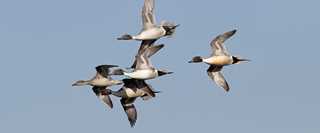
Photo © Michael Furtman
Fast and graceful fliers, pintails are equipped with long wings, small heads, and long necks that seem built for streamlined aerodynamics. Both sexes have blue gray bills and gray legs and feet.
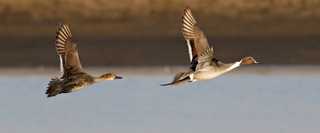
Photo © Michael Furtman
The drake, however, looks most striking, with a thin white stripe running from the back of its chocolate-colored head down its neck to its mostly white undercarriage. The drake also has attractive gray, brown, and black patterning on its back and sides.

Photo © Michael Furtman
The hen's plumage is more subtle and subdued, with drab brown feathers similar to those of other female dabblers. Hens make a coarse quack and the drakes a flutelike whistle.
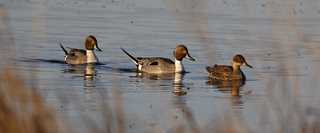
Photo © Michael Furtman
Because of their wide-ranging migrations pintails have been called "nomads of the skies." When good wetland conditions occur, pintails breed in native grasslands and in pastures and farm fields, mainly in the Prairie Pothole Region of Canada and the United States.
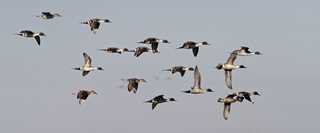
Photo © Michael Furtman
They prefer the shallow, seasonal wetlands found in these areas and are usually the first ducks to arrive on the prairies in spring. But when the prairies are dry, more than half of the breeding birds are surveyed in northern Canada and Alaska. And some travel as far as Siberia.

Photo © Michael Furtman
Few outdoor experiences are as awe-inspiring as the sight of a pintail cupping its wings and plummeting from great heights into a decoy spread. Unfortunately, this sight is not as common as it once was. Just a few decades ago, pintails trailed only mallards as the most abundant duck in North America.
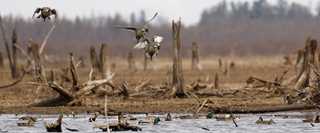
Photo © Michael Furtman
Now they are among the least abundant dabbling ducks on this continent. Since research has shown that habitat loss and changes in farming practices are responsible for the pintail's decline, DU is working hard with farmers and ranchers to implement wildlife-friendly agricultural practices such as the cultivation of winter wheat on the pintail's breeding grounds and flooding of harvested rice fields on their wintering grounds. DU also protects and restores wetlands and associated uplands on key breeding, migration, and wintering areas used by pintails and other waterfowl. For more information on pintails, go to www.ducks.org/ThePintail.
Ducks Unlimited uses cookies to enhance your browsing experience, optimize site functionality, analyze traffic, and deliver personalized advertising through third parties. By continuing to use this site, you agree to our use of cookies. View Privacy Policy